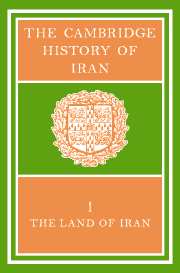Book contents
- Frontmatter
- PART 1 THE LAND
- 1 PHYSICAL GEOGRAPHY
- 2 GEOLOGY
- 3 GEOMORPHOLOGY
- 4 THE ORIGIN OF THE ZAGROS DEFILES
- 5 CLIMATE
- 6 SOILS
- 7 HYDROGRAPHY
- 8 VEGETATION
- 9 MAMMALS
- 10 ZOOGEOGRAPHIC ANALYSIS OF THE LIZARD FAUNA OF IRAN
- 11 ORNITHOLOGY
- PART 2 THE PEOPLE
- PART 3 ECONOMIC LIFE
- PART 4 CONCLUSION
- Bibliography
- Conversion Tables
- Fig. I. Iran: physiographical.
- Plate Section
- Fig 85. Soil potentiality map of Iran.
- References
5 - CLIMATE
from PART 1 - THE LAND
Published online by Cambridge University Press: 28 March 2008
- Frontmatter
- PART 1 THE LAND
- 1 PHYSICAL GEOGRAPHY
- 2 GEOLOGY
- 3 GEOMORPHOLOGY
- 4 THE ORIGIN OF THE ZAGROS DEFILES
- 5 CLIMATE
- 6 SOILS
- 7 HYDROGRAPHY
- 8 VEGETATION
- 9 MAMMALS
- 10 ZOOGEOGRAPHIC ANALYSIS OF THE LIZARD FAUNA OF IRAN
- 11 ORNITHOLOGY
- PART 2 THE PEOPLE
- PART 3 ECONOMIC LIFE
- PART 4 CONCLUSION
- Bibliography
- Conversion Tables
- Fig. I. Iran: physiographical.
- Plate Section
- Fig 85. Soil potentiality map of Iran.
- References
Summary
INTRODUCTION
As with many other countries of the world, Iran is somewhat unfortunate in having recorded no long-term climatic observations. Climatic studies and observations are usually stimulated either by scientific interest or practical necessity; and whilst the weather exerts a decisive influence on nearly all phases of human activities, it is particularly in the fields of agriculture and aviation that a sound meteorological knowledge becomes essential, both for long-term planning as well as for day-to-day operations. Here it must be admitted, with regret, that until the World War II years, neither of the above incentives to meteorological studies received much attention in Iran. In the early years of the war, however, the country became a vital area, considered by the Allies the “Bridge of Victory” for the transport of essential wartime supplies to Russia. Roads had to be built under various climatic conditions, and traffic maintained in all kinds of weather. Soon a network of airways was established all over the country, and it was not long before Tehrān became the largest and most strategic air base of the Middle East. Then came the wartime food shortages and famines all over the Middle East, particularly in Iran where there occurred successive years of drought and crop failure. The country was made as self-supporting as possible. Consequently a great deal of attention was focused on its agricultural potentialities, the assessment of which required adequate knowledge of climatic conditions. A number of research projects were introduced and put into operation, and so a new movement began in the field of climatic studies.
- Type
- Chapter
- Information
- The Cambridge History of Iran , pp. 212 - 249Publisher: Cambridge University PressPrint publication year: 1968
References
- 13
- Cited by

